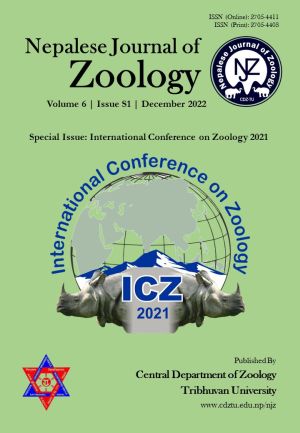Species diversity of reptiles in Palpa District, Nepal
DOI:
https://doi.org/10.3126/njz.v6iS1.50526Keywords:
Agricultural fields; Diversity indices; Forests; Human habitats; Riparian; WetlandAbstract
Gastrointestinal (GI) This study was conducted in agricultural field, forests, riparian and wetland habitats, and human habitats of six sampling sites in Palpa, Nepal, from May 2016 and April 2020. The purpose of the study was to document and measure the richness, abundance, and diversity of the reptile in this district. Data was collected randomly in these habitats of this district using quadrat, visual encounter, and opportunistic survey methods. For 100 quadrates for each site seasonally, 20 quadrats were placed in each habitat along 5 transects. In total, 554 individual species belonging to 9 families, 26 genera, and 34 species were recorded. The richness of reptiles species was high in the human habitat and forest (S= 25) but lower in wetland (S=6). The abundance was more in human habitat than in other habitats. Shannon diversity index (Hˈ) of reptile was 2.51 and 0.99 in forest and wetland respectively. Similarly, the Simpson index in reptiles (λ) was high in forest (0.87) and low in wetland (0.57). Pielou evenness (J) of individuals among the species was 0.29 in forest and 0.54 in wetland. The values indicate that the diversity of reptiles was higher in forest as compared to the wetland. This study aids the resources for additional research.
Downloads
Downloads
Published
How to Cite
Issue
Section
License
Copyright (c) 2022 Pit Bahadur Nepali, Nanda Bahadur Singh

This work is licensed under a Creative Commons Attribution-NonCommercial 4.0 International License.
This license enables reusers to distribute, remix, adapt, and build upon the material in any medium or format for noncommercial purposes only, and only so long as attribution is given to the creator.

